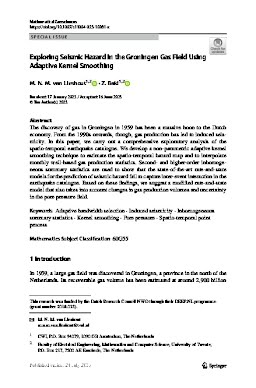2024-08-01
Exploring seismic hazard in the Groningen gas field using adaptive kernel smoothing
Publication
Publication
Mathematical Geosciences , Volume 56 p. 1185- 1206
The discovery of gas in Groningen in 1959 has been a massive boon to the Dutch economy. From the 1990s onwards, though, gas production has led to induced seismicity. In this paper, we carry out a comprehensive exploratory analysis of the spatio-temporal earthquake catalogue. We develop a non-parametric adaptive kernel smoothing technique to estimate the spatio-temporal hazard map and to interpolate monthly well-based gas production statistics. Second- and higher-order inhomogeneous summary statistics are used to show that the state-of-the-art rate-and-state models for the prediction of seismic hazard fail to capture inter-event interaction in the earthquake catalogue. Based on these findings, we suggest a modified rate-and-state model that also takes into account changes in gas production volumes and uncertainty in the pore pressure field.
| Additional Metadata | |
|---|---|
| , , , , , | |
| doi.org/10.1007/s11004-023-10081-x | |
| Mathematical Geosciences | |
| Organisation | Stochastics |
|
van Lieshout, M.-C., & Baki, Z. (2024). Exploring seismic hazard in the Groningen gas field using adaptive kernel smoothing. Mathematical Geosciences, 56, 1185–1206. doi:10.1007/s11004-023-10081-x |
|

